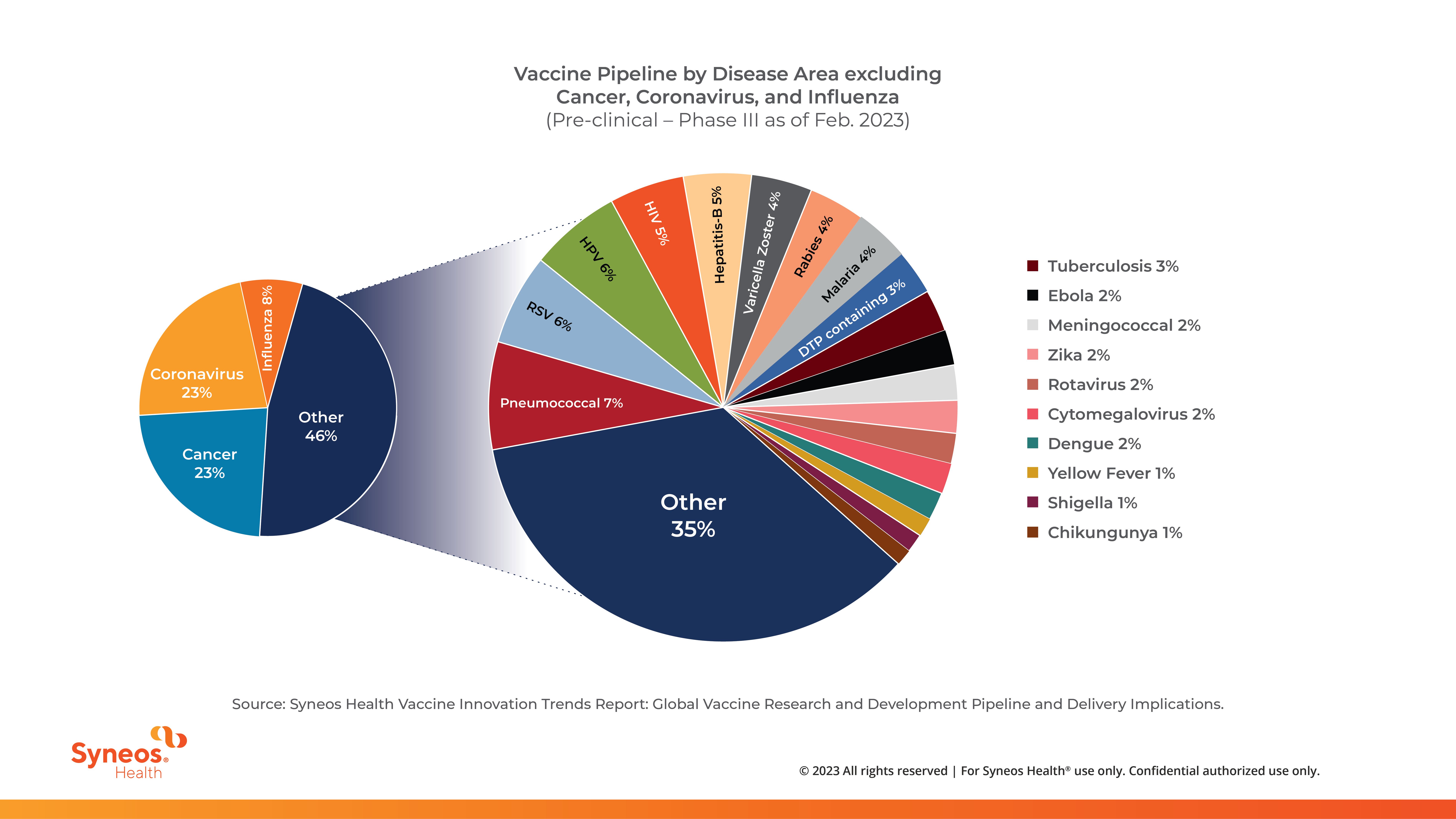- Sustainability
- DE&I
- Pandemic
- Finance
- Legal
- Technology
- Regulatory
- Global
- Pricing
- Strategy
- R&D/Clinical Trials
- Opinion
- Executive Roundtable
- Sales & Marketing
- Executive Profiles
- Leadership
- Market Access
- Patient Engagement
- Supply Chain
- Industry Trends
The Global Vaccine R&D Pipeline and Delivery Implications
The current vaccine pipeline brings promise of significant global health advancements—yet development gaps remain, and the future delivery challenges must be considered.
AdobeStock 199783080, Medical hands holds syringe and vaccine | Image Credit: © Alernon77 - stock.adobe.com

Vaccines have long been hailed as one of the most effective tools in safeguarding public health worldwide. Vaccines are instrumental in preventing more than 20 diseases and annually avert an estimated 3.5 to 5 million deaths.1 Moreover, they play a pivotal role in combatting emerging infectious diseases and curbing the spread of microbial resistance.2
The COVID-19 pandemic has undoubtedly accelerated the growth of global vaccine markets and research and development (R&D). In this context, we have witnessed increased collaboration between manufacturers, the private sector, academia, and governments. The pandemic has also led to unprecedented speed in vaccine development and fostered a growing interest in technology transfers, which are expected to have lasting impacts on the vaccine development landscape.
However, despite this remarkable progress, significant challenges remain in achieving equitable access to vaccines and furthering the development of lifesaving immunizations. The disruption to health systems caused by the COVID-19 pandemic resulted in the largest setback to childhood vaccination in three decades.3 This disruption has highlighted the need to address barriers to vaccine accessibility and availability, especially in lower-income countries.
The vaccine development pipeline
Syneos Health, with a contract from the Bill & Melinda Gates Foundation, has prepared a trends report that outlines the current vaccine development pipeline and its potential impact on health systems. Understanding the current pipeline and its potential impact is essential to guide sustainable investment in global public health.
Figure 1. Vaccine pipeline by disease area excluding cancer, coronavirus, and influenza.4 More than half of pipeline vaccine candidates target cancer, coronavirus, and influenza while the remaining 46% of the pipeline focuses on various infectious diseases, with vaccines for many other global health priority diseases, such as Zika, yellow fever, shigella, and Chikungunya.

A close look at the vaccine development pipeline reveals important insights. Notably, more than half of pipeline vaccine candidates target cancer, coronavirus, and influenza. The remaining 46% of the pipeline focuses on various infectious diseases, with vaccines for many other global health priority diseases, such as Zika, yellow fever, shigella, and Chikungunya, representing significantly smaller portions of the pipeline, according to company data.
Excluding cancer, more than 70% of pipeline candidates are directed toward disease areas where at least one vaccine is already available, according to the same company data. While this does have positive implications for access, such as new formulations and combinations that could alleviate coverage barriers and increase competition, potentially resulting in lower prices, development needs remain for other novel vaccines.
Additionally, by reducing infection, transmission, opportunities for pathogen mutation, and antibiotic use, vaccines are recognized as a key tool in combating the rising global threat of antimicrobial resistance (AMR).5 Nine percent of the global vaccine development pipeline targets AMR threats identified by WHO and CDC.5,6 However, less than half of these candidates target priority pathogens for which no vaccines are currently available.
Overall, the current global vaccine development pipeline holds a promise of significant value and global benefit, but it also reveals an imbalance in global vaccine R&D priorities, as there is limited development in many priority disease areas.
The cost of future equitable access to vaccines
Looking to the future, key challenges lie in the implications of introducing numerous potential vaccines. An analysis was performed to identify potential key vaccine introductions for low- and middle-income countries through 2035. Nearly 14 new additional projected vaccines may be introduced into recommended vaccination schedules by 2035. (Please note that dates for new vaccine recommendations are projections and should be considered directional estimations). This could represent a six-fold increase in recommended vaccines since 1980.7,8 Notably, the impact on the adult platform is particularly significant, with three times the number of vaccines projected to be recommended for adults in global public health markets. Significant investment may be required to enable further vaccine introductions for adult and maternal populations that previously had a limited number of recommended vaccines.
Assuming a moderate hypothetical scenario, the introduction of seven out of the 14 identified vaccines could lead to a 90% increase in vaccine cost per fully vaccinated person, a 20% increase in the cost to countries, and a 95% increase in the cost to global health partners, according to company data. New vaccine introductions may strain already stretched country immunization budgets, which are still integrating new recommendations, such as COVID-19 and malaria vaccines. There is an opportunity for schedule optimization, combination vaccine development, and investment prioritization to alleviate challenges and ensure sustainable delivery of new vaccines.
Vaccines are critical to global public health, preventing the spread of numerous diseases and saving millions of lives each year. The unprecedented growth and collaboration in the vaccine industry, particularly in response to the COVID-19 pandemic, present exciting opportunities for advancing public health. However, it is vital to address the challenges of equitable access and development for priority disease areas. Sustainable investments and robust preparation will be key to ensuring the global community can realize the full benefits of current vaccine R&D and planned vaccine introductions.
References
- WHO, “Vaccines and Immunization,” accessed March 2023.https://www.who.int/health-topics/vaccines-and-immunization#tab=tab_1
- WHO, “Immunization Agenda 2030: A Global Strategy to Leave No One Behind,” accessed March 2023. https://www.who.int/teams/immunization-vaccines-and-biologicals/strategies/ia2030
- WHO, “COVID-19 Pandemic Fuels Largest Continued Backslide in Vaccinations in Three Decades,” accessed March 2023. https://www.who.int/news/item/15-07-2022-covid-19-pandemic-fuels-largest-continued-backslide-in-vaccinations-in-three-decades
- Analysis based on Citeline, Pharmaprojects data for ongoing, active preclinical – Phase III vaccine development as of February 16, 2023.
- WHO, “Leveraging Vaccines to Reduce Antibiotic Use and Prevent Antimicrobial Resistance,” accessed March 2023. https://www.who.int/publications/m/item/leveraging-vaccines-to-reduce-antibiotic-use-and-prevent-antimicrobial-resistance
- CDC, “Antibiotic Resistance Threats in the United States: 2019” (December 2019). https://www.cdc.gov/drugresistance/pdf/threats-report/2019-ar-threats-report-508.pdf
- WHO, “Table 1: WHO Recommendations for Routine Immunization,” Nov. 16, 2021. https://www.who.int/publications/m/item/table-1-who-recommendations-for-routine-immunization
- WHO, “Immunization Data Portal,” accessed March 2023. https://immunizationdata.who.int/listing.html
Katherine Berry is a senior engagement manager, value and consulting; Luly Dickinson is a senior consultant, value and consulting; Katie Mahoney is a public relations professional, value and consulting, all at Syneos Health®.
Cell and Gene Therapy Check-in 2024
January 18th 2024Fran Gregory, VP of Emerging Therapies, Cardinal Health discusses her career, how both CAR-T therapies and personalization have been gaining momentum and what kind of progress we expect to see from them, some of the biggest hurdles facing their section of the industry, the importance of patient advocacy and so much more.
Nipocalimab Demonstrates Sustained Disease Control in Adolescents with Generalized Myasthenia Gravis
October 16th 2024Results from the Phase II/III Vibrance-MG study found that patients with generalized myasthenia gravis who were treated with nipocalimab plus standard-of-care achieved sustained disease control.
